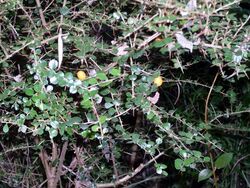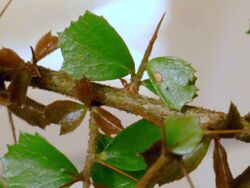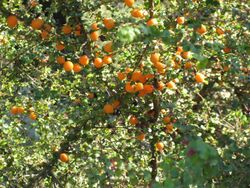Biology:Pittosporum multiflorum
| Orange thorn | |
|---|---|

| |
| Orange thorn at Eastwood, Australia | |
| Scientific classification | |
| Kingdom: | Plantae |
| Clade: | Tracheophytes |
| Clade: | Angiosperms |
| Clade: | Eudicots |
| Clade: | Asterids |
| Order: | Apiales |
| Family: | Pittosporaceae |
| Genus: | Pittosporum |
| Species: | P. multiflorum
|
| Binomial name | |
| Pittosporum multiflorum (A.Cunn. ex Loudon) L.W.Cayzer, Crisp & I.Telford
| |
| Synonyms | |
| |
Pittosporum multiflorum, known as the orange thorn, is a shrub growing in eastern Australia .[1] The dense foliage provides a habitat for small birds and animals.[citation needed] It grows on shales or volcanic soils,[citation needed] from Eden, New South Wales north to Queensland, usually in or near rainforest areas.[1]
Description
Pittosporum multiflorum grows from one to three metres in height. Thickly branched with small spines. Leaves almost circular, 3 to 12 mm long, practically without leaf stalks. Mostly toothed, through rarely entire. Flowering occurs in spring or summer. The orange fruit often persists on the plant. Regeneration from fresh seed is slow but fairly reliable. The plant is very similar to the closely related Pittosporum spinescens, but is readily distinguished by its toothed leaf margins.[citation needed]
The 1889 book 'The Useful Native Plants of Australia records that common names included "Native Orange" and "Orange Thorn" and that "The fruit is an orange berry with a leathery skin, about one inch and a half in diameter. The seeds are large. It is eaten by the aboriginals [sic.]."[2]
Taxonomy
It was first described in 1832 as Citriobatus multiflorus by Allan Cunningham,[3] and was transferred to the genus, Pittosporum, by Lindy Cayzer, Michael Crisp and Ian Telford in 2000.[3][4]
References
- ↑ 1.0 1.1 "PlantNET - FloraOnline: Pittosporum multiflorum". http://plantnet.rbgsyd.nsw.gov.au/cgi-bin/NSWfl.pl?page=nswfl&lvl=sp&name=Pittosporum~multiflorum.
- ↑ J. H. Maiden (1889). The useful native plants of Australia : Including Tasmania. Turner and Henderson, Sydney. https://primo-slnsw.hosted.exlibrisgroup.com/primo-explore/fulldisplay?docid=SLNSW_ALMA21105097830002626&context=L&vid=SLNSW&search_scope=EEA&tab=default_tab&lang=en_US.
- ↑ 3.0 3.1 "Pittosporum multiflorum". Australian Plant Name Index (APNI), IBIS database. Centre for Plant Biodiversity Research, Australian Government. https://biodiversity.org.au/nsl/services/rest/name/apni/146653.
- ↑ Cayzer, L.W., Crisp, M.D. & Telford, I.R.H. (2000). "Revision of Pittosporum (Pittosporaceae) in Australia". Australian Systematic Botany 13 (6): 864–865. doi:10.1071/SB99021.
Wikidata ☰ Q7199145 entry
 |



